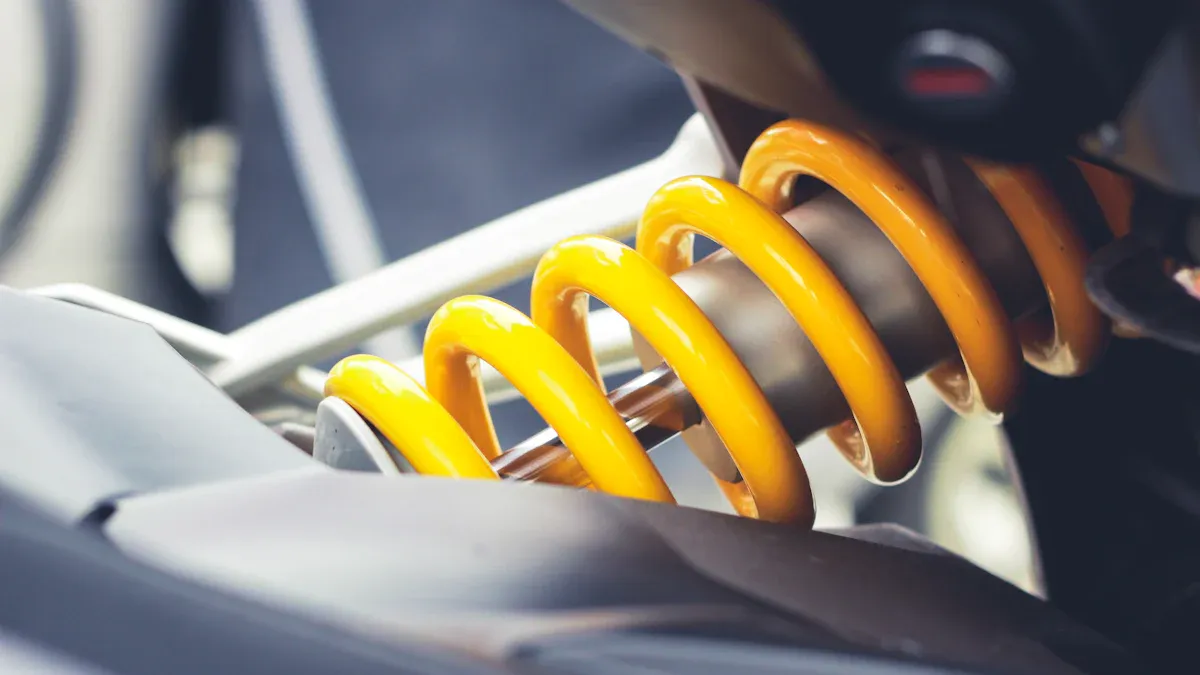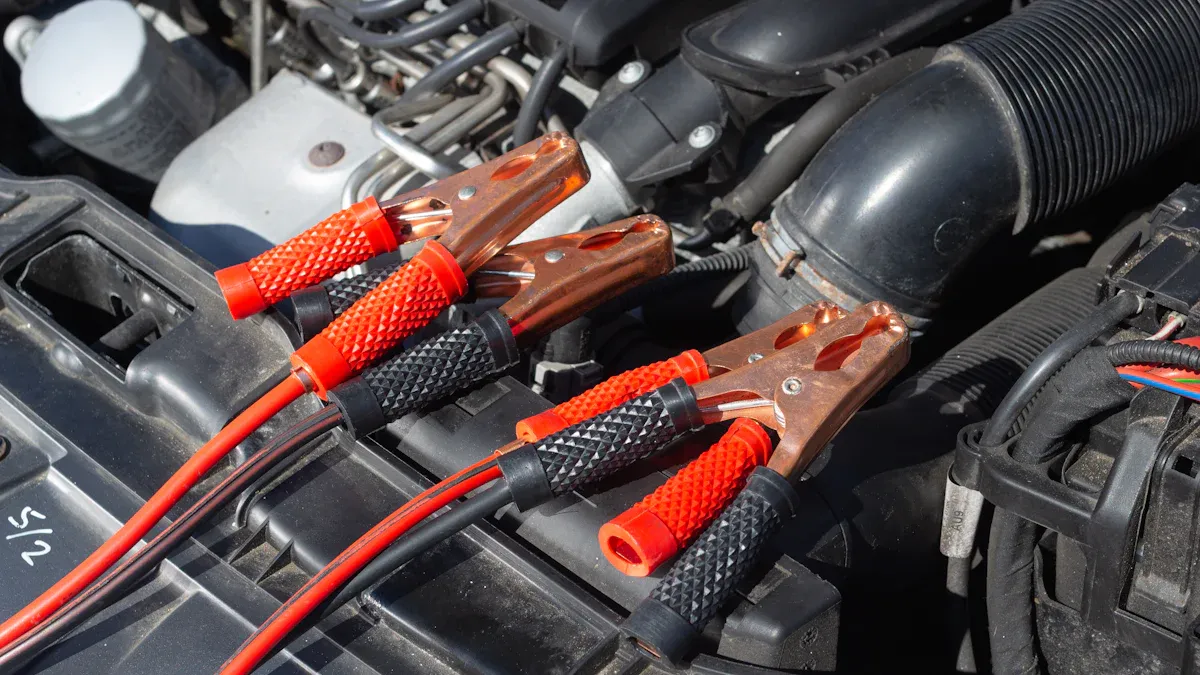
You can achieve total mastery over your ride’s feel and performance through advanced shock tuning. By learning to tune the damper for perfect compression and rebound, you will unlock performance far beyond what your shock’s external knobs can offer.
Let’s get you started on adjusting your shim shock, which is the secret to a truly custom mountain bike suspension. A well-tuned shock is the key to delivering ultimate suspension performance and a ride that feels tailor-made for you.
Why Shim Tuning Beats External Adjusters
You probably use the external knobs on your shock absorbers to adjust your ride. These knobs are useful for small adjustments. However, they are not the main source of damping control. True custom shock tuning happens at a much deeper level inside the damper.
The Real Source of Damping Control
The heart of your suspension damper is the shim stack. Shims are thin, flexible metal discs stacked on a piston. When your suspension compresses or rebounds, oil is forced through ports in this piston. The shim stack bends to allow oil to pass. The stiffness of this stack controls how much resistance the oil meets. This resistance is your damping force. Adjusting these shims is the secret to professional-level performance shock valving. It allows you to change the fundamental character of your suspension.
Understanding the Limits of Knobs
Your external adjustment knobs typically control a “bleed circuit.” Think of this as a small, secondary hole that bypasses the main piston. This system has significant limitations. When fluid approaches this small orifice, the flow creates high shear forces and resistance, which restricts fluid movement. This is very different from how the main shim stack works.
Damping System Showdown: Knobs vs. Shims
- Knob Adjusters (Orifice Damping): At low shaft speeds, the main shim stack stays closed. All oil must squeeze through the tiny bleed circuit. The damping force increases very quickly with speed, which can feel harsh.
- Shim Stack Damping: At a certain speed, the pressure becomes strong enough to “crack open” the shim stack. As the shims bend more, the flow area increases. This allows the shock to absorb big, fast hits without feeling overly stiff.
Ultimately, knobs only influence low-speed damping. They cannot change the high-speed behavior of your shock. To control how your suspension handles both small chatter and large impacts, you must modify the shim stack itself. This is what separates factory settings from a truly dialed-in ride. Advanced dampers rely on this internal tuning for their superior feel and performance.
The Anatomy of a Shim Shock System

To tune your shim shock, you first need to understand its core components. The magic of professional-level suspension tuning happens within the damper, where a few simple parts create a highly sophisticated system for controlling compression and rebound.
What Are Shims and How Do They Work?
Shims are the most critical suspension components inside your damper. They are thin, spring-steel discs of varying diameters and thicknesses. You will find them stacked on the main piston. As your suspension moves, it forces oil through ports in the piston. These shims bend or flex to let the oil pass. The stiffness of this stack of shims dictates the damping force.
Temperature and Oil: A Critical Relationship The oil inside your shock gets thinner as it heats up. This change in viscosity affects damping force. Even a small change in temperature can alter how the oil flows, which changes the pressure needed to open the shim stack. This is why high-quality dampers are designed to manage heat effectively.
The Compression Shim Stack Explained
The compression shim stack controls how the shock absorbs impacts. Different parts of the stack handle different hit speeds. This allows you to tune for both small-bump sensitivity and big-hit support. Many advanced dampers use separate circuits for low and high-speed hits.
| Feature | Low-Speed Circuit | High-Speed Circuit |
|---|---|---|
| Mechanism | A needle controls flow through a small orifice | A piston and shim stack |
| Function | Manages slow movements like pedaling or braking | Determines the force needed to open the stack on fast hits |
| Tunability | Set by an external knob | Tuned by changing the shims |
You can create even more advanced damping profiles using special components. For example, a “crossover” shim can create a two-stage feel. It allows the suspension to be soft initially and then become firmer deeper in the travel.
The Rebound Shim Stack Explained
The rebound stack controls how quickly your suspension returns to its original position after an impact. Proper rebound tuning is essential for maintaining traction. If rebound is too slow, the suspension can “pack down” on repeated hits and feel harsh.
Lighter rebound damping allows the wheel to return to the ground faster. This quick response reduces suspension packing, especially over rocky sections. The rebound circuit also includes a check valve. This valve lets oil flow freely around the rebound shims during the compression stroke, ensuring the two circuits do not interfere with each other. This design helps the shock settle quickly and keeps your tires glued to the trail.
Gearing Up: Tools for Shim Shock Adjustment

Working on your shock’s internals requires precision and the right equipment. You will need more than a standard set of hex wrenches to properly disassemble and reassemble these advanced components. Gathering your tools beforehand makes the process smoother and safer.
Essential Tools for the Job
You should start with a clean workspace and a way to secure your shock, like a soft-jawed vise. The specific tools you need will depend on your shock model. For example, servicing a Fox Float X2 requires different tools than a RockShox Super Deluxe. However, a general toolkit for servicing suspension components will include:
- Basic Hand Tools: A good set of hex wrenches, a torque wrench, various sockets, and needle-nosed pliers.
- Specialty Shock Tools: You will likely need shaft clamps to hold the damper shaft without scratching it. Custom spanner sockets are often necessary to remove bearing housings or valve assemblies.
- Fluid Management: A waste oil basin is essential for catching old suspension fluid cleanly.
- Safety Gear: Always have safety glasses and nitrile gloves ready.
Pro Tip: Get the Right Tools 🔧 Never try to substitute tools. Using the wrong tool, like adjustable pliers instead of a proper shaft clamp, can permanently damage your shock. Always consult your shock manufacturer’s service manual for the exact tools required.
Safety First: Prepping Your Suspension
Safety is the most important part of any suspension service. You are working with pressurized chambers and oil, so you must take proper precautions. Your first and most critical step is to release all pressure from the shock.
Before you unthread anything, you must completely depressurize both the main air chamber and the Internal Floating Piston (IFP) chamber. Forgetting this step can cause the shock to fly apart with dangerous force, potentially causing serious injury.
Follow these safety steps every time:
- Wear Your PPE: Put on your safety glasses and gloves before you begin. Suspension fluid can irritate your skin and eyes.
- Work in a Ventilated Area: Good airflow helps disperse any oil fumes.
- Release All Pressure: Use a shock pump or valve core tool to let all the air out of the main air can. Follow the manufacturer’s guide to safely release the nitrogen charge from the IFP.
- Document Everything: Take photos as you disassemble the shock. This creates a visual guide for reassembly.
A Step-by-Step Guide to Modifying Your Shim Stack
Now you are ready for the hands-on part of advanced shock tuning. This guide walks you through the process of modifying your shim shock. Remember to work slowly and methodically. Your patience will pay off with a perfectly tuned ride.
Accessing the Damper Piston
Your first goal is to safely get to the piston and its shim stacks. This process involves careful disassembly. Always refer to your specific shock’s service manual, as steps can vary.
- Depressurize Completely: You must release all air pressure before starting. This is a critical safety step.
- First, release all air from the main air chamber using your shock pump.
- Next, you need to depressurize the Internal Floating Piston (IFP). Depending on your model, you might do this by depressing a valve core with a tool. On other designs, you will carefully undo a 4mm Allen fill screw to let the pressure release slowly.
- Remove the Air Can: You can now unthread the main air can from the shock body. It may be tight, so use a strap wrench if needed to avoid scratching the surface.
- Secure the Damper: Clamp the shock body in a soft-jawed vise. This gives you a stable platform to work on.
- Access the Piston Assembly: You will now need to remove the seal head assembly to pull the main damper shaft out of the shock body. This often requires a model-specific tool. Once it is unthreaded, you can slide the entire piston and shaft assembly out.
⚠️ A Word of Caution You are working with a precision-engineered piece of equipment. Never force parts that do not move easily. Consult your service manual if you get stuck. Taking your time prevents costly damage.
Identifying and Changing Shims
With the damper assembly on your workbench, you can finally see the components that control your suspension feel. The piston is held on the shaft with a nut. The shims are stacked on either side of the piston.
- Lay Everything Out: Place a clean, lint-free towel on your workbench. Carefully remove the piston nut. As you remove the piston and shims, lay them out in the exact order they came off. Taking a photo with your phone is a great way to remember the sequence.
- Identify the Stacks: You will see two separate stacks. The compression stack is on one side of the piston, and the rebound stack is on the other. Your service manual can help you confirm which is which.
- Make Your Changes: This is where the magic happens. You can change the damping by altering the stack. You might add a shim, remove one, or change the diameter of a shim. Make only one small change at a time. This helps you understand how each adjustment affects the ride.
Reassembly and Final Checks
Proper reassembly is just as important as the disassembly. You must be meticulous to ensure your shock functions safely and correctly. This involves bleeding the damper, setting the IFP depth, and torquing everything to spec.
Bleed the Damper: You must remove all air from the oil. Air contamination causes a problem called cavitation, where tiny bubbles form and collapse. This can damage internal parts and make your suspension performance inconsistent.
- To bleed the system, you will fill the shock body with fresh fluid.
- Slowly cycle the damper shaft up and down within the oil. This pushes trapped air bubbles to the surface.
- Top off the fluid and repeat until no more bubbles appear. Professional shops use vacuum bleeding machines for a perfect bleed, but you can achieve good results manually with care.
Set the IFP Depth: The IFP separates the oil from the pressurized nitrogen gas. Its position, or depth, is critical. If it is wrong, your shock could “hydro-lock” and fail to achieve full travel.
- You will use a special IFP depth setting tool for this.
- Apply a thin film of Slick Honey grease to the IFP seal and insert it into the reservoir.
- Push the IFP to the manufacturer-specified depth. For example, some Fox shocks require a depth of 3 inches, measured from the edge of the reservoir.
Torque to Spec: Once the damper is bled and the IFP is set, you can complete the reassembly. Use a torque wrench for all fasteners to avoid damage.
Pro Tip: Follow the Manual 📖 Manufacturer specifications are not suggestions. For example, the manual for a FOX GRIP X2 damper states you must tighten the seal head to exactly 150 in-lb (16.9 Nm). It also requires 1-2 drops of blue Loctite 243 on the threads. Always follow these precise instructions.
Final Pressurization and Test:
- Re-pressurize the IFP chamber to the specified PSI.
- Reinstall the air can and pressurize the main chamber.
- Install the shock back on your bike. Compress the suspension a few times to make sure it moves smoothly through its travel. Listen for any strange noises and feel for any harsh spots.
Congratulations! You have successfully completed your first custom shim stack adjustment. Now it is time to hit the trail and feel the difference.
How to Read and Tune Your Suspension’s Shim Stack
You can think of shims as the ingredients for your suspension’s damping recipe. The diameter, thickness, and stacking order of these shims all work together. Understanding each element allows you to fine-tune your ride with precision.
The Role of Shim Diameter
The diameter of a shim changes how easily it bends. Larger diameter shims flex more easily, which creates a softer feel. You can use this principle to create advanced damping curves. For example, you can add a “crossover” shim to your stack.
What is a Crossover Shim? ⚙️ A crossover is a smaller diameter shim placed between larger ones. This creates a small gap in the stack. For small, fast bumps, oil pressure only has to bend the shims before the gap. This gives your suspension a soft, plush feel. On big hits, the pressure is high enough to push the first shims across the gap, engaging the full, stiffer stack for support.
How Shim Thickness Affects Damping
Shim thickness has the biggest impact on damping force. A thicker shim is much stiffer than a thinner one. The relationship is not linear; a small increase in thickness creates a large increase in stiffness. In fact, a shim’s stiffness is roughly proportional to its thickness cubed. This means doubling a shim’s thickness makes it about eight times stiffer.
When tuning, you might not have the exact shim you need. You can stack two thinner shims to increase damping, but it is not the same as using one thick shim. Two 0.10mm shims together will create a “bit softer” damping feel than a single 0.20mm shim. This is a great trick for making very fine adjustments.
Stacking Order and Its Impact
The order in which you arrange the shims on the piston defines the damping curve. Different arrangements change how the damper responds to various impacts.
- Pyramid Stack: The most common arrangement is a pyramid, with the largest diameter shims against the piston, followed by progressively smaller ones. This creates a smooth, progressive damping force that gets firmer as the shock compresses faster.
- Two-Stage Stack: By using a crossover shim, you change the order to create two distinct damping stages. This gives you a soft initial feel for comfort and a firm end-stroke to prevent bottoming out.
Changing the stacking order is the key to moving beyond factory settings. It allows you to build a custom performance profile that perfectly matches your riding style.
Troubleshooting Your Ride with Shim Adjustments
Your hard work pays off on the trail. You can now diagnose ride problems and use your new skills to fix them. This is the final step in true custom shock tuning. Each adjustment you make will teach you more about how your suspension works.
Fixing Harshness on Small Bumps
Does your bike feel harsh over small, chattery bumps like roots and rocks? Does the shock feel like it “freezes solid” when you hit a sharp-edged pothole? This feeling comes from too much high-speed compression damping. Your goal is to make the shim stack softer so it can open more easily on these fast hits.
The shims in the top half of the stack will have a greater effect on high-speed damping. The shims in the bottom half will have a greater effect on low-speed.
To reduce that harsh feeling, you need to decrease high-speed compression damping. You can do this while keeping your low-speed support for pedaling and cornering. You have two main options:
- Remove a Face Shim: The “face shims” are the largest diameter shims sitting directly against the piston. Removing one of these makes the initial force required to open the stack much lower. This is a significant change that dramatically softens the high-speed feel.
- Remove a Support Shim: The smaller shims further down the stack act as a brace for the larger face shims. Removing one of these support shims allows the face shims to flex more easily. This provides a more subtle adjustment than removing a face shim.
Start with a small change. Try removing a single, small support shim first. This will give you a good feel for how the adjustment affects your ride.
Adding Support to Prevent Bottoming Out
Are you using all of your shock’s travel too easily? Bottoming out on big jumps or drops feels jarring and can damage your shock or frame. This problem means you need more high-speed compression support. You need to make your shim stack stiffer to handle these large, fast impacts.
You can add support by doing the opposite of what you did to fix harshness. You will add shims to the compression stack.
| Tuning Action | Resulting Feel | Best Use Case |
|---|---|---|
| Add a Face Shim | A large increase in overall compression damping. | You need a major increase in support for very aggressive riding. |
| Add a Support Shim | A smaller, more progressive increase in damping. | You want to prevent bottoming out without making the ride harsh. |
| Use a Thicker Shim | A significant increase in stiffness. | You need a firm setup for racing or hitting very large features. |
Adding a small support shim is often the best first step. It increases end-stroke support without sacrificing too much small-bump sensitivity. This helps your suspension feel plush at the top but strong at the bottom.
Dialing in Your Rebound Speed
Rebound damping controls how fast your shock returns after an impact. Getting this right is critical for traction and control.
🎯 Tuning Goal: Your rebound should be as fast as possible without feeling bouncy or uncontrolled. This allows the wheel to stay in contact with the ground.
Problem: The shock “packs down” and feels harsh. If your rebound is too slow, the shock cannot extend fully between repeated hits. It “packs” deeper into its travel with each bump. This makes the ride feel stiff and harsh.
- Solution: You need to speed up your rebound. Remove one of the smaller shims from the rebound stack. This reduces the damping and allows the shock to return faster.
Problem: The bike feels bouncy and loses traction. If your rebound is too fast, the wheel springs back with too much force. This can make the bike feel like a pogo stick. It can also cause the tire to lose contact with the ground, reducing your grip.
- Solution: You need to slow down your rebound. Add a shim to the rebound stack to increase damping. This will give you a more controlled and planted feel.
Remember to make one small change at a time. A single shim can make a noticeable difference in your rebound speed.
You now understand the ultimate tool for personalizing your suspension. Shim shock adjustments let you move beyond factory settings. This advanced shock tuning allows you to create a ride feel just for you.
You can truly master your shock. Make small, documented changes to your shim shock. This detailed shock tuning will transform your suspension. Start experimenting and feel the incredible difference on the trail.
FAQ
Can I reuse my shock oil?
You should never reuse old shock fluid. Used oil contains tiny metal particles and loses its viscosity. Always use fresh, manufacturer-recommended oil. This protects your shock’s internal parts and ensures consistent damping performance for a better ride.
Where can I buy different shims?
You can find shims from specialty suspension tuning shops online. Some shock manufacturers also sell them directly. Always verify that the shims you buy are the correct inner and outer diameter for your specific shock model.
What happens if I install a shim upside down?
Shims are flat, so they do not have an upside down. However, the stacking order is extremely important. Incorrectly ordering the components will dramatically alter your damping curve. You should always lay parts out carefully during disassembly.
Do I need nitrogen to recharge my shock?
Yes, you must use nitrogen for the IFP chamber. Nitrogen is a dry gas that behaves predictably under temperature changes. Using regular air introduces moisture. This moisture can damage sensitive internal suspension components and cause inconsistent performance.
